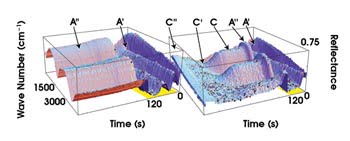Hank Hogan
Researchers at Stanford University in California have devised a Fourier transform infrared (FTIR) reflectivity monitoring technique that determines simultaneously the temperature and optical properties of a superconducting film as it is being deposited. As a result, they found that the superconductor, yttrium barium copper oxide (YBCO), has a number of previously unknown phases and undergoes unexpected phase boundary crossings.

Shown here are Fourier transform infrared reflectivity spectra (ranging from 0 to 100%) recorded during deposition (0 to 120 s) and postannealing (>120 s) of yttrium barium copper oxide. The figure on the left shows that, if the deposit is not exposed to the right amount of oxygen, only an amorphous phase is formed (A'), as evidenced by strong interference fringes. On the right, exposing the deposit to oxygen formed crystalline yttrium barium copper oxide (C, C' and C''), with the spectrum of C'' that of a metallic material, and the interference eventually disappears. Reprinted with permission of the American Institute of Physics.
These findings are being used in an attempt to produce an economical superconducting tape. However, researcher Gertjan Koster noted that the monitoring method may have another role to play.
“As far as the FTIR technique itself, depending on the process control requirements, it could play a future role in the fabrication of such tape,” he said.
Key to the success of the technique was the use of an online instrument and associated software from MKS Instruments Inc. of Wilmington, Mass. Originally developed to measure the absolute surface temperature of semiconductors, the detector consisted of a HgCdTe infrared sensor cooled with liquid nitrogen. Koster noted that a similar arrangement had been used for measuring the temperature of a sample, but not while probing optical properties at the same time.
In their setup, the researchers used an infrared light source and associated optics to illuminate a 5-mm2 section of the sample, which was located inside a processing chamber. After entering through a transparent port, the infrared light reflected off the sample, exited through another transparent port and traveled back out of the chamber, where optical elements and an interferometer collected the light and sent it into the detector.

By chopping the light source, the researchers had regular intervals with both reflectance and radiance present as well as other times with only the sample’s radiance. This approach enabled them to measure temperature and to assess optical properties simultaneously.
When they were engaged in their investigations, they used electron beam sources inside the chamber to deposit the film on the sample while they monitored the process with the instrumentation. One source supplied yttrium, another supplied barium, and the last provided copper, with the deposition taking place in the presence of oxygen in a partial vacuum. The researchers studied the growth of the YBCO on two types of substrates, one crystalline and the other metal tape.
Unexpectedly, they observed temperature discontinuities arising from heat-generated transitions from one phase to another. In looking at those same points using reflected light, they saw shifts in refractive index. Again, these resulted from phase changes taking place while the YBCO was being deposited at an elevated temperature, cooled to room temperature while being oxidized and then was becoming metallic. The exact trajectory that the film took on this path depended upon the temperature and oxygen pressure.
Koster, who now is an assistant professor of inorganic materials science at the University of Twente in the Netherlands, noted that there were some hints of these results in previous x-ray diffraction data, but that x-ray diffraction could not be used on amorphous prephases of the film. “I don’t think we could have done it without FTIR,” he said of the experiment.
The Stanford group is using its findings in attempts to produce cheap superconducting tape, which could be used in a number of applications. As for the FTIR technique, it could be used to monitor the growth of other oxide systems. However, Koster cautioned that doing so would require additional modeling to be able to handle highly transparent thick films in a more quantitative fashion.
Applied Physics Letters, June 25, 2007, Vol. 90, 261917.